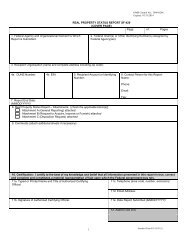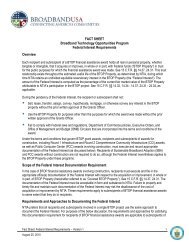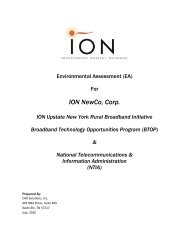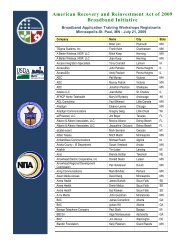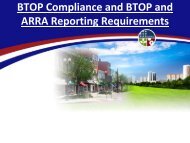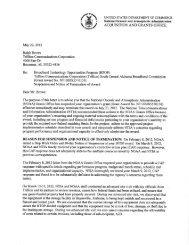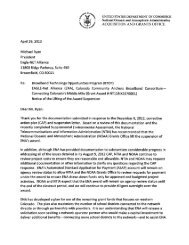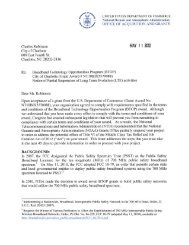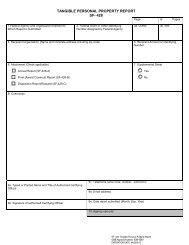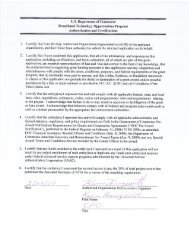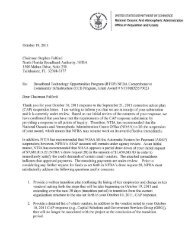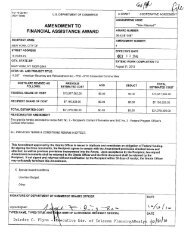Grant Guidelines for the RECOVERY ACT BROADBAND ...
Grant Guidelines for the RECOVERY ACT BROADBAND ...
Grant Guidelines for the RECOVERY ACT BROADBAND ...
You also want an ePaper? Increase the reach of your titles
YUMPU automatically turns print PDFs into web optimized ePapers that Google loves.
47. Historical Financial Statements: Please provide <strong>the</strong> following financial statements <strong>for</strong><br />
<strong>the</strong> last two (2) years: a) Income Statement; b) Balance Sheet; and c) Statement of Cash Flows<br />
(CPA audits if available); start‐up firms should provide <strong>the</strong> most recent financial statements.<br />
The applicants must submit a detailed set of financial statements or reports associated with<br />
<strong>the</strong>ir organization’s regular operating activities and financial status. A standard annual Income<br />
Statement, Balance Sheet, and Statement of Cash Flows based on generally accepted<br />
accounting principles (GAAP) is preferable. If multiple agencies or key partnerships are involved<br />
in <strong>the</strong> proposed project, <strong>the</strong> applicant may use discretion on whe<strong>the</strong>r to include <strong>the</strong> historical<br />
financial statements <strong>for</strong> <strong>the</strong> partners.<br />
If your organization cannot readily produce this data in a standard <strong>for</strong>mat, you should explain<br />
why not, and provide comparable data, such as figures collected in your most recent IRS Form<br />
990 report, or in an annual accounting and financial audit, that provides as detailed a picture as<br />
possible of your financial history <strong>for</strong> a minimum of two years (or, if less, <strong>the</strong> length of time your<br />
organization has been in business) prior to your submission of this application. If appropriate,<br />
you may include Notes on Financial Statements to include explanation of cost and revenue<br />
breakdowns by major categories as appropriate, and you may make note of any abnormal or<br />
one‐time charges, large liabilities or asset transactions, legal actions, and any o<strong>the</strong>r financial<br />
events you feel require explanation.<br />
48. Broadband Subscriber Estimates: Please download and upload Attachment H,<br />
regarding subscriber projections, including households, businesses, community anchor<br />
institutions, public safety entities, and/or critical community facilities <strong>for</strong> each of your service<br />
offerings, along with a brief description of <strong>the</strong> methodology used to <strong>for</strong>ecast this on a separate<br />
sheet. For last mile subscribers, provide your estimated take rate (<strong>the</strong> percentage of total<br />
customers passed who will subscriber to your service), along with a brief description of <strong>the</strong><br />
methodology used to <strong>for</strong>ecast this.<br />
Attachment H will be available online. Applicants can download <strong>the</strong> attachment, complete <strong>the</strong><br />
<strong>for</strong>m, and upload <strong>the</strong> <strong>for</strong>m back to <strong>the</strong> online tool.<br />
All applicants <strong>for</strong> last mile infrastructure projects should indicate <strong>the</strong>ir subscriber <strong>for</strong>ecasts with<br />
a breakdown by type of subscriber (households, businesses, community anchor institutions,<br />
public safety entities, and critical community facilities) and service offerings. Last mile<br />
applicants also must provide an estimate of <strong>the</strong> “take rate,” which is <strong>the</strong> number of customers<br />
that will subscribe to <strong>the</strong> applicant’s proposed service divided by <strong>the</strong> total number of customers<br />
passed by <strong>the</strong> applicant’s proposed facilities. They may do this on a separate sheet of paper.<br />
‐ 50 ‐ 7/10/2009



